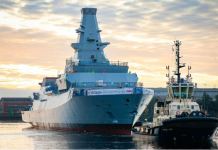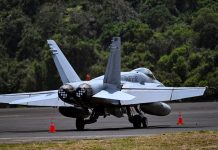By Commodore G Prakash
INS Nistar was commissioned today by the Defence Minister of India at Visakhapatnam. This massive ship, by warship standards, was built by the Hindustan Shipyard Limited in Visakhapatnam. Nistar’s sister ship, Nipun, is also expected to be commissioned later in the year.
These ships are not the standard fighting ships, such as Destroyers or Frigates. They have been designed to carry a Deep Submarine Rescue Vehicle (DSRV) each, which will significantly enhance the Indian Navy’s operational and strategic capabilities.
They will be capable of rescuing personnel stuck underwater on stricken submarines, a service that will be of use to every country that deploys its submarines in our region.
These ships are also Diving Support Vessels (DSVs) that can impart world-class training in deep-sea diving. That is another capability that can be used for the collective benefit of interested countries in our region. Together, these capabilities make the Nistar & Nipun special ships that give a boost to India’s benign power.
The need to make provisions for escape from stricken submarines underwater is critical. However, locating stricken submarines, communicating with them, sending trained personnel down in specialised equipment to connect up with submarines at great depths, and bringing them to safety in small batches is extremely difficult.
The technical difficulties are matched by prohibitive costs as well. This puts this capability beyond the reach of many countries. Therefore, we have reason to be proud.
The Indian Navy began inducting submarines in 1969. These were conventional Russian submarines of the Foxtrot class, whose operational capabilities could be greatly enhanced when supported at sea.
This support was in the form of repairs, replenishment, and rest & recreation at sea for the crew for the duration of repairs or replenishment. INS Amba, a submarine Depot Ship, was inducted from Russia for this.
Acknowledging the importance of providing credible methods for rescue to our submariners, we also inducted INS Nistar from existing Russian reserves. Commissioned on 29 March 1971, Nistar was capable of sending a module called Bell, which contained divers, and mating it with escape hatches atop submarines. Thereafter, the crew could be rescued in batches of eight.

The old Nistar was also designed to train deep-sea divers to the level of Saturation Diving, which enables them to carry out specialised tasks at great depths underwater, staying there for prolonged durations.
This ship also had the necessary equipment for the associated compression and decompression requirements. The induction of the old Nistar enabled the Indian Navy to create a competent Diving Cadre that ultimately helped us create the formidable Marine Commandoes and Clearance Divers capable of carrying out a host of actions, including Explosive Ordnance Disposal underwater.
As the old Nistar aged, there was a necessity to retain our capability for underwater rescue and diving training. Between 1982 and 1987, various European Submarine Rescue Vessels were evaluated for their suitability.
Each of these had pros and cons for Indian conditions. A study was also carried out on the utilisation of the US Navy’s air-portable DSRVs. However, as our country was not in a financial position to afford these, an interim alternative solution had to be found.
This solution was the acquisition of a DSV that the Mazagon Docks Limited had originally built for ONGC’s offshore oil exploration work, complete with a dynamic positioning facility and a recompression chamber.
The Navy took this vessel on dry charter and fitted her with the diving bell and other essential rescue equipment removed from the aged Nistar. After some years of trials, this DSV was commissioned in September 1995 as INS Nireekshak.
Though she was not designed for underwater rescue, trials using her and submerged submarines were successful. This ship remains in commission along with all her capabilities. However, there was a need to modernise and further expand our underwater rescue capabilities.
Discussions initiated with the US Navy in the early 1990s didn’t have much success, and the process got derailed with the Pokharan nuclear tests in May 1998. Although discussions were resumed in February 1999, it took a considerable amount of time for us to successfully take the next step.
This came in the form of two Deep Submarine Rescue Vessels (DSRVs) bought from the UK-based company JFD between 2018 and 2019. At over ten metres in length and a width of over three metres, these twenty-seven-ton craft resemble mini-submarines.
These can be piloted down to 650 metres, mated with the escape hatches of submerged submarines, and slant even up to a steep 60 degrees, rescuing personnel in batches of up to 17.
The DSRVs are also supported by a Remote Operating Vehicle (ROV) and a Side Scan Sonar for locating submarines. Although the new DSRVs had been proven at sea and training had been imparted, there were no dedicated ships to carry them.
The interim solution involved hiring civilian ships and retaining them at a great cost to ensure assured availability at all times. There was also a need to modernize our diving training capabilities and enhance the ability to physically observe, carry out repairs, and handle objects at greater depths.
The new INS Nistar and her soon-to-be commissioned sister ship, INS Nipun, complete all the requirements for underwater rescue and training. Most importantly, as ships dedicated to the purpose and stationed one on each coast, they will always be available for immediate deployment.
With a displacement of over 8,500 tons, Nistar is a mammoth ship, one of the largest in our Navy, and also one of the most unconventional-looking. The enhancement in her capabilities can be imagined from the fact that the old INS Nistar was 800 Tons and INS Nireekshak is about 2200 Tons.
The ship is propelled by two six-megawatt diesel engines and features six Diesel Generators with a combined generation capacity of 13 megawatts, sufficient to power approximately 8,000 urban households.
As staying accurately above a submerged submarine or a diving site is a critical capability, Nistar is capable of staying rock steady within a radius of five square metres in rough seas up to Sea State 4. It is her second-generation Dynamic Positioning (DP 2) system that enables her to do it.
All systems and machinery on board are managed by an indigenously developed Integrated Platform Management System (IMPS) that can be operated from multiple stations. It is also encouraging to learn that on this indigenously designed and built ship, the percentage of indigenous equipment is over 80%.
For diving training, the ship has a diving bell capable of taking up to six divers to a depth of 300 metres (for a saturation dive), a diving suite that can house up to 12 members in Decompression Chambers, a 15-ton crane that can reach depths of 650 meters, and ROVs that can descend to 1000 metres. It also features a unique Hyperbaric Life Boat that can facilitate the evacuation of saturation divers under pressure in emergencies.
The ship per se can accommodate about 220 people on board and has a state-of-the-art eight-bedded hospital with an ICU and an OT where critical surgeries can be performed at sea. The ship can operate helicopters from a deck located at the front of the ship, and it carries the standard naval armaments and surveillance capabilities typical of this class of ships.
While Nistar brings on a leap in capabilities for the Indian Navy, what is important to note is that this ship and her follow-on ship will usher in a new era for underwater rescue, training, and repair capabilities that have potential gains for the entire Indian Ocean Region (IOR), especially those countries that deploy submarines in the IOR.
The global fleet of submarines is steadily increasing. The laws of physics provide submarines with nearly unassailable advantages of stealth compared to ships. Ever-increasing silencing technologies are steadily increasing these advantages further.
Great leaps in weapon and sensor technologies are increasing the destructive power of submarines. As nations adapt their maritime military operational doctrines to cater to the ever-evolving geopolitical pressures, the type of weapons on board submarines is also becoming increasingly lethal.
An increasing number of countries appear to be in the process of modifying their force structures to leverage the advantages provided by submarines for nuclear deterrence, intelligence and surveillance, the delivery of Special Forces, and sea denial and area control.
With all this, the current average of approximately 70 submarines from different countries known to be operating in the IOR at any given time is set to increase in the coming years.
There is also the ever-increasing proliferation of underwater infrastructure worldwide, which necessitates significantly enhanced qualitative and quantitative capabilities for underwater work of all types, with and without human intervention. The requirement for training in this field is immense.
The commissioning of INS Nistar and INS Nipun later in the year is a great leap for India in its ability to shoulder the regional responsibilities expected of it.
Leadership positions always come with associated obligations. The acquisition of critical niche capabilities is unaffordable to all, and selfless service using them for friends and foes in distress is a core leadership responsibility.
As part of various regional groupings, including IONS, BIMSTEC, WPNS, IORA, and QUAD, the newfound capacities in providing world-class underwater rescue, diving training, repair, and handling capabilities are a significant asset.
- Commodore G. Prakash is a former Naval Aviator and an ASW specialist who has served as Captain of three warships & has operated from Sea King 42B helicopters. He speaks and writes on a wide range of strategic & military topics.
- Mail EurAsian Times at: editor (at) eurasiantimes.com




